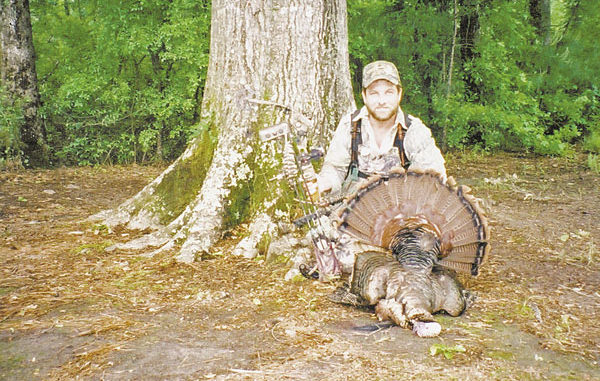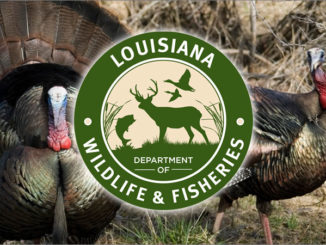
Expert offers advice on how to up the odds when hunting public-land turkeys
Shane Johnson dreams of having a nice, turkey-filled private lease. But he’s never had that privilege, so he’s fought the public-land battle for years.
And he’s won more than he’s lost, logging his 99th kill last season.
So when he offers advice on how to put yourself in position to kill gobblers, it’s a good time to shut up and listen.
Here are his top tips to kill a turkey — and these steps work even if you’re a member of a turkey-hunter’s nirvana.
1) Preparation, preparation, preparation — Showing up opening day and hoping to find a hot bird is a formula for failure, Johnson said.
“It’s kind of like leaning on the shovel and asking God to give you a hole,” he said. “I do a lot of work and preparation to try and locate birds early.
In other words, Johnson’s season starts long before it’s legal to carry a gun into the woods.
He scouts out likely locations, and his goal is to have several birds located before the season opens.
And then it’s just a process of elimination to figure out which ones to target.
For instance, a turkey that’s located close to a road or ATV trail probably will be nixed from Johnson’s target list because it’s likely other hunters have found it, as well.
“I may never go back to a bird that’s located like that,” Johnson said. “I try to be smart about my selection.”
2) Get there first — Killing a longbeard is about more than just knowing where it roosts.
Johnson said it’s imperative to be in the woods long before daylight so you can be the first to catch its attention.
“My favorite, ideal thing is to get in there early,” he said. I like to be the first one talking to him,” he said. “I wake up soft, soft, hen talking like they do early in the morning.”
But as day breaks the veteran hunter sort of goes overboard.
“I’m going to an aggressive flydown,” Johnson said. “I’ll do some excited clucking back to back; I use a wing to simulate a fly-down. I might even scratch the ground.”
“My kids laugh at me and give me a hard time.”
But this approach is virtually guaranteed to get a response from the gobbler.
“Unless (the turkey) is homosexual, I usually get a response when I do that,” Johnson said. “But that’s all about being the first one to communicate with it.
“It doesn’t matter if another hunter is in the area — if that turkey responds to me first, they’re in trouble.”
Johnson’s competition is almost guaranteed to lose out on any turkey at that point.
“That turkey will shut up when another hunter calls, but I can literally do a single cluck and get him to gobble because he’s responding to me,” he said.
3) Hang out a while — At what point in the day do you throw in the towel? If you’re one of the masses of hunters who figures if you haven’t fired a shot by mid-morning you won’t have any luck, Johnson said you’re making a big mistake.
“When it gets way up in the morning, I slow way down,” he said. “I’m really, really deliberate.”
That’s not because gobblers won’t sound out, but they get a little more laid back and take longer to respond.
“I’m real deliberate about waiting,” Johnson said. “If I don’t hear anything, instead of moving in two or three minutes I’ll stay put an extra 10 minutes.”
4) Get closer — Turkey hunting is somewhat about overcoming nature.
“He’s waiting on you to come to him,” Johnson said. “It’s not natural for him to come to you.”
So getting a gobbler’s attention — especially after the early morning rush is past — is all about space.
“My goal is I want to get as close to him as I can get before calling,” Johnson said. “I don’t want a long-distance conversation.
“When I call to him and I’m right up there in his zone, a lot of times he will come on in.
“If you’re calling to him from 100 yards, he might not come to you. But if you get to within 50 yards, more than likely he’s coming to you.”
5) Set a date, and then keep it — One of Johnson’s real secrets takes several days to develop, but it’s also been one of his most-successful tactics.
It’s designed to use his lunch and after-work hours, when he only has a few minutes to focus on turkeys.
“I’ll sneak into the same spot for four, five, sometimes six days in a row and call,” Johnson said. “Then I’ll break and run to the truck and go back to work.”
That’s right: His goal isn’t really to hunt. Instead, it’s to let the gobblers in the area know where they can find a hen.
“When the weekend gets there, I’ll actually go in there and set up,” Johnson said. “He’s been listening to me for three, four, five days in a row. More than likely, within an hour I’ll call up that gobbler and kill it.”
6) Spit and drum — You thought the last tip was wild. Well, it gets weirder.
Johnson said his calls actually go beyond clucks and purs to include spitting and drumming, which is highly effective when targeting heavily pressured birds.
“When I’m public-land hunting, I don’t really want to make that turkey gobble because that only attracts other hunters,” he said. “I have learned to spit and drum at it with my natural voice.”
He actually worked with Rod Haydel at one point trying to develop a call to mimic these sounds, but the team could never pull it off.
But he’s continued to do it — and gobblers continue to respond.
Johnson admitted that many hunters probably don’t really recognize the sounds, which include a little pzzt sound and a deep rumble.
“It sounds about like an old Ford stuck in the mud way off,” Johnson said.
And it’s something gobblers do constantly this time of year.
“They literally do that 24/7 during the spring,” Johnson said.
Because it’s a gobbler “call,” utilizing this tactic acts as a direct challenge to any gobbler in the area — much like a gobble call. But it’s safer than a gobble because other hunters 1) probably won’t hear it and 2) usually won’t recognize it as a turkey call.
And what happens is that a gobbler will charge in without every sounding off for every hunter on the WMA to hear.
“It doesn’t make him gobble 90 percent of the time — but it makes him mad,” Johnson said.
And a mad gobbler quickly turns to a dead gobbler.
7) Work the angles — What do you do when a turkey hangs up? Quit? Call louder? Mutter profanities?
Johnson said he moves closer (remember tip No. 4?), but how and when he moves to the bird is important.
“A lot of times he’s hung up because there’s an obstacle between you and him,” he said. “So it helps to know the terrain.
“But sometimes he’s hard-headed and just waiting for you to come to him.”
That’s when Johnson moves, but he never moves unless the turkey has gobbled.
“You don’t move unless you have him responding to you so you know where he is,” he explained.
Once he knows where the gobbler is located, he’ll make his move — but not straight at the bird.
“I try to move in angles,” Johnson said. “I move at 45-degree angles; that way I don’t run straight into it.”


